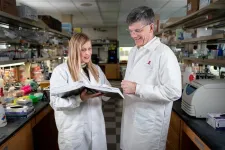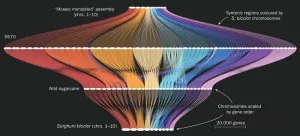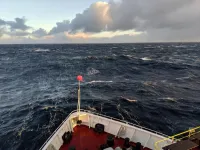(Press-News.org)
There are several factors that play an important role in the development of floods: air temperature, soil moisture, snow depth, and the daily precipitation in the days before a flood. In order to better understand how individual factors contribute to flooding, UFZ researchers examined more than 3,500 river basins worldwide and analysed flood events between 1981 and 2020 for each of them. The result: precipitation was the sole determining factor in only around 25% of the almost 125,000 flood events. Soil moisture was the decisive factor in just over 10% of cases, and snow melt and air temperature were the sole factors in only around 3% of cases. In contrast, 51.6% of cases were caused by at least two factors. At around 23%, the combination of precipitation and soil moisture occurs most frequently.
However, when analysing the data, the UFZ researchers discovered that three – or even all four – factors can be jointly responsible for a flood event. For example, temperature, soil moisture, and snow depth were decisive factors in around 5,000 floods whilst all four factors were decisive in around 1,000 flood events. And not only that: “We also showed that flood events become more extreme when more factors are involved”, says Dr Jakob Zscheischler, Head of the UFZ Department “Compound Environmental Risks” and senior author of the article. In the case of one-year floods, 51.6% can be attributed to several factors; in the case of five- and ten-year floods, 70.1% and 71.3% respectively can be attributed to several factors. The more extreme a flood is, the more driving factors there are and the more likely they are to interact in the event generation. This correlation often also applies to individual river basins and is referred to as flood complexity.
According to the researchers, river basins in the northern regions of Europe and America as well as in the Alpine region have a low flood complexity. This is because snow melt is the dominant factor for most floods regardless of the flood magnitude. The same applies to the Amazon basin, where the high soil moisture resulting from the rainy season is often a major cause of floods of varying severity. In Germany, the Havel and the Zusam, a tributary of the Danube in Bavaria, are river basins that have a low flood complexity. Regions with river basins that have a high flood complexity primarily include eastern Brazil, the Andes, eastern Australia, the Rocky Mountains up to the US west coast, and the western and central European plains. In Germany, this includes the Moselle and the upper reaches of the Elbe. “River basins in these regions generally have several flooding mechanisms”, says Jakob Zscheischler. For example, river basins in the European plains can be affected by flooding caused by the combination of heavy precipitation, active snow melt, and high soil moisture.
However, the complexity of flood processes in a river basin also depends on the climate and land surface conditions in the respective river basin. This is because every river basin has its own special features. Among other things, the researchers looked at the climate moisture index, the soil texture, the forest cover, the size of the river basin, and the river gradient. “In drier regions, the mechanisms that lead to flooding tend to be more heterogeneous. For moderate floods, just a few days of heavy rainfall is usually enough. For extreme floods, it needs to rain longer on already moist soils”, says lead author Dr Shijie Jiang, who now works at the Max Planck Institute for Biogeochemistry in Jena.
The scientists used explainable machine learning for the analysis. “First, we use the potential flood drivers air temperature, soil moisture, and snow depth as well as the weekly precipitation – each day is considered as an individual driving factor – to predict the run-off magnitude and thus the size of the flood”, explains Zscheischler. The researchers then quantified which variables and combinations of variables contributed to the run-off of a particular flood and to which extent. This approach is referred to as explainable machine learning because it uncovers the predictive relationship between flood drivers and run-off during a flood in the trained model. “With this new methodology, we can quantify how many driving factors and combinations thereof are relevant for the occurrence and intensity of floods”, adds Jiang.
The findings of the UFZ researchers are expected to help predict future flood events. “Our study will help us better estimate particularly extreme floods”, says Zscheischler. Until now, very extreme floods have been estimated by extrapolating from less extreme floods. However, this is too imprecise because the individual contributing factors could change their influence for different flood magnitudes.
END
A systematic review of 35 years of global medical literature finds a spectrum of reasons why people sell kidneys. The study, by Bijaya Shrestha of the Center for Research on Education, Health and Social Science, Kathmandu, Nepal, finds limited efforts toward mitigating the problem as well as a lack of evidence around the impact of policy and biotechnology. It is published in the open access journal PLOS Global Public Health.
Demand for kidney donation is higher than supply, and it has become one of the most saleable human ...
St. Jude Children’s Research Hospital scientists reversed an aggressive cancer, reverting malignant cells towards a more normal state. Rhabdoid tumors are an aggressive cancer which is missing a key tumor suppressor protein. Findings showed that with the missing tumor suppressor, deleting or degrading the quality control protein DCAF5 reversed the cancer cell state. These results suggest a new approach to curing cancer — returning cancerous cells to an earlier, more normal state rather than killing cancer cells with toxic therapies — may be possible. The results were published today in Nature.
“Rather than making a toxic event that kills rhabdoid ...
SAN ANTONIO — March 27, 2024 —Southwest Research Institute is leading two groundbreaking experiments — on the ground and in the air — to collect astronomical data from the total solar eclipse that will shadow a large swath of the United States on April 8, 2024. SwRI’s Dr. Amir Caspi leads the Citizen Continental-America Telescopic Eclipse (CATE) 2024 experiment, a broad scientific outreach initiative funded by the National Science Foundation (NSF) and NASA, that will ...
New multidisciplinary research from the University of St Andrews could lead to more efficient televisions, computer screens and lighting.
Researchers at the Organic Semiconductor Centre in the School of Physics and Astronomy, and the School of Chemistry have proposed a new approach to designing efficient light-emitting materials in a paper published this week in Nature (27 March).
Light-emitting materials are used in organic light-emitting diodes (OLEDs) that are now found in the majority of mobile ...
Modern hybrid sugarcane is one of the most harvested crops on the planet, used to make products including sugar, molasses, bioethanol, and bio-based materials. It also has one of the most complex genetic blueprints.
Until now, sugarcane’s complicated genetics made it the last major crop without a complete and highly accurate genome. Scientists have developed and combined multiple techniques to successfully map out sugarcane’s genetic code. With that map, they were able to verify the specific location that provides resistance to the impactful brown rust disease ...
WASHINGTON — The Wide-field Imager for Parker Solar Probe (WISPR) Science Team, led by the U.S. Naval Research Laboratory (NRL), captured the development of turbulence as a Coronal Mass Ejection (CME) interacted with the ambient solar wind in the circumsolar space. This discovery is reported in the Astrophysical Journal.
Taking advantage of its unique location inside the Sun’s atmosphere, the NRL-built WISPR telescope on NASA’s Parker Solar Probe (PSP) mission, operated by the Johns Hopkins University Applied Physics Laboratory (JHUAPL), captured in unparalleled detail the interaction between ...
Four years after the U.S. shut down in the face of the COVID-19 pandemic, research from Rice University suggests undocumented immigrants’ mental health challenges were compounded due to stresses stemming from their unauthorized status.
“Implications of Undocumented Status for Latinx Families During the COVID-19 Pandemic: A Call to Action” appears in the Journal of Clinical Child & Adolescent Psychology and examines how undocumented immigrants navigated the COVID-19 pandemic.
During a series of in-depth interviews with undocumented individuals or those from ...
Planes, trains, boats, automobiles and even feet. During the past decades and centuries, global travel and human migration have made all of us more worldly — from our broadening awareness of the world beyond our birthplaces, to our more sophisticated palates, to our immune systems that are increasingly challenged by unfamiliar bacteria and viruses.
In the elderly, these newly imported pathogens can gain the upper hand frighteningly quickly. Unfortunately, however, vaccination in this age group isn’t as effective as it is in younger people.
Now a study conducted in mice by Stanford ...
Scientists have uncovered a key step in the wound healing process that becomes disabled in diseases like diabetes and ageing, contributing to a global healthcare cost of managing poorly healing wounds exceeding $250 billion a year. Importantly, the research published in Nature reveals a molecule involved in the healing of tissues that – when injected into animal models – leads to a drastic acceleration of wound closure, up to 2.5 times faster, and 1.6 times more muscle regeneration.
Lead researcher, Associate Professor Mikaël Martino, from Monash University’s Australian Regenerative Medicine Institute (ARMI) in Melbourne, Australia, said the discovery ...
It carries more than 100 times as much water as all the world's rivers combined. It reaches from the ocean's surface to its bottom, and measures as much as 2,000 kilometers across. It connects the Indian, Atlantic and Pacific oceans, and plays a key role in regulating global climate. Continuously swirling around the southernmost continent, the Antarctic Circumpolar Current is by far the world's most powerful and consequential mover of water. In recent decades it has been speeding up, but scientists have been unsure whether ...








